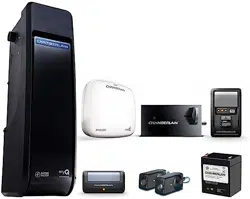Loading ...
Loading ...
Loading ...

14
Approx. 3"
(7.6 cm)
2
3 4
5
6
Installation (continued)
Install Power Door Lock
5
1. Pull down on the manual release to
disengage the door and open the door
manually.
2. Clean track surface, and attach lock
template to the track.
3. Drill holes as marked on the template.
You may find it useful to pre-drill
the holes with a smaller bit before
proceeding to larger sizes, or use a
step drill bit.
4. Fasten power door lock to the outside
of the garage door track with
1/4"-20x1/2" screws provided.
5. Run wire up wall to garage door
opener. Use insulated staples to secure
wire in several places.
6. Insert wire through the bottom of
the garage door opener and plug the
connector into the garage door opener.
A secondary door lock can be installed on
the opposite side of the door by following
the instructions above.
Position the Cable Tension Monitor (Required)
6
The cable tension monitor detects any slack in the garage
door cables. When slack is detected, the garage door
opener stops the door from closing, and reverses the
door to stay open. The cable tension monitor MUST be
connected and properly installed BEFORE the garage door
opener will move in the down direction.
The cable tension monitor must be installed on the
same side as the garage door opener. Factory default is
configured for left-side installation.
1. Determine if the cable tension monitor will be installed
on the left or right side of the door.
2. For left-side installation, skip to Step 3. For right-side
installation ONLY, remove the c-clip from the roller shaft,
move the roller to the other side, and reinstall the c-clip.
3. Make sure the door cable is approximately 3/4" (19 mm)
from the mounting surface.
4. Position the cable tension monitor 2" to 6" (5-15 cm)
from the drum, and over a wood support surface.
- Shim or add wood block if needed. The cable tension
monitor MUST be flush with the mounting surface.
- Cable tension monitor roller must be free from
obstructions.
NOTE: No obstructions should exist that prevent the cable
tension monitor from closing completely when slack is
detected.
YOU WILL NEED
Screw
1/4"-20x1/2" (2)
2" to 6"
(5-15 cm)
Approx. 3/4"
(19 mm)
shim if
needed
Cable tension
monitor
Drum
1
Approx. 3"
(7.6 cm)
Loading ...
Loading ...
Loading ...
